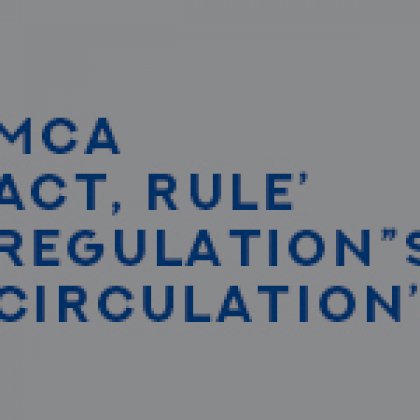What are the RBI Payment Gateway API Guidelines

Payment API Gateway Guidelines and Mechanism
1.1 Payments in the online space are facilitated by a number of intermediaries like the payment gateways and payment aggregators. These intermediaries act as the bridge between the providers of goods/services (merchants) and those that require them (customers). For a successful online experience, the role of such intermediaries is crucial.
1.2 The intermediaries involved in payment collection and settlement between customers and merchants range from banks providing payment gateway services, non-bank aggregators of merchants and payment options/instruments, technology service providers supporting payment gateway operations, and e-commerce marketplaces.
1.3 Extant regulations in this area, albeit indirect, were issued by the Reserve Bank of India (RBI) during November 2009 which required banks to maintain a nodal account of the intermediaries with permissible credits and debits as also the settlement cycle for the credit to the merchants. This nodal account was required to be in the form of an ‘internal account’ of the bank.
1.4 The instructions were motivated with a view to safeguard the interests of the customers and users and to ensure that the payments made by them using electronic/digital/online payment modes were duly accounted for by the intermediaries receiving such payments and transmitted to the accounts of the merchants or to similar other entities.
1.5 There have been no changes to these guidelines since its issue. Payment Systems in India has witnessed rapid changes in the last decade. The facilitating role of innovation, fintech, expanding e-commerce activities, etc., has contributed to the impressive growth. In this fast-changing scenario, it is opportune to review if the extant guidelines / regulatory prescriptions are adequate. It is also time to see if a regime of direct regulation is warranted.
1.6 In its Monetary Policy Statement for 2018-19 dated February 7, 2019, RBI had indicated that the existing guidelines for Payment Intermediaries would be reviewed. This discussion paper covers the various facets of the activities of the Payment Gateways and Payment Aggregators and presents different options for their regulation.
2. Payment Gateways and Payment Aggregators
2.1 In an online payment transaction, the following entities/players are generally involved – the seller (merchant), the customer (buyer), customer’s bank/wallet account, acquiring bank, the bank has the nodal account, IT and communication hardware/software, middleware, security systems, payment gateways, and payment aggregators. The means opted for payment could be a credit card, debit card, bank account, wallet, Unified Payments Interface (UPI), etc. Depending on the payment mode used, additional players like card networks, NPCI (National Payments Corporation of India), banks offering net-banking services, banks / non-banks issuing wallets, etc. may be part of the payment chain.
2.2 Payment Gateways and Payment Aggregators refer to entities who –
provide technology infrastructure to route and/or facilitate the processing of an online payment transaction and perform other functions without actually handling the funds. Facilitate e-commerce sites and merchants to accept various payment instruments from the customers for completion of their payment obligations to the merchants without the need for merchants to create a separate payment integration system of their own. Facilitate merchants to connect with acquirers. In the process, they receive payments from customers, pool, and transfer them on to the merchants after a time-lag. Apart from handling funds, they also get access to customer data.
2.3 Payment Gateways and Payment Aggregators may also provide services that include generation of settlement via netting of the funds received by the merchants on-boarded by them. By being the bridge between consumers at one end and merchants at the other end, these service providers play a role in processing and completion of the payment transactions. They could be engaged by a bank, a merchant, or a biller (utility company, telecom, etc.).
2.4 Payment Gateways and Payment Aggregators engaged by a bank: Payment Gateways and Payment Aggregators may be engaged by a bank to enable the latter to provide its customers services like bill payments, card payments, etc. – across its various banking channels and through the use of cards/bank accounts. Such aggregators generally (i) provide the technology interface for the services, (ii) enter into arrangements with biller/utility entities, (iii) manage the daily operational complexities of dealing with multiple utilities (each with a disparate technology platform) in different locations, (iv) provide the banks one standardized – centralized manner of dealing with the bill-data of various utilities, (v) take care of various biller/utility requirements of MIS, reconciliation, consolidated payouts, and other service delivery aspects, etc.
2.5 Payment Gateways and Payment Aggregators engaged by a merchant/biller: Merchants may also engage Payment Gateways and Payment Aggregators to provide transaction management/consolidation services for managing collections/payments through various payment modes. This normally includes (i) online transaction processing across various banks/card gateways to enable the merchant’s customers to conduct online transactions, (ii) recurring transaction processing on bank accounts/cards accounts (through NACH, banks, card networks, etc.), (iii) reconciliation, MIS, transaction-to-fund flow match, etc., (iv) transaction support, technology interface support, etc.
2.6 Currently most of the acquiring is done by third party aggregators and technology providers. There, entities may also provide cross border settlement services and are governed by guidelines issued by the Foreign Exchange Department (FED, RBI) on Online Payment Gateway Service Providers (OPGSPs).
3 Concerns and Gaps
3.1 The activities of Payment Gateways and Payment Aggregators in online transactions are extremely crucial. Entities may be a source of risk in such a technology and customers experience intensive business if they have inadequate governance practices which may impact customer confidence and experience.
3.2 The customer ordinarily has very limited access to the Payment Gateways and Payment Aggregators and must rely on merchants or banks who only can seek redress from the Payment Aggregators. Lack of proper redress mechanism and uniformity in practice across the entities is also a matter of concern.
3.3 It is however a fact that the present guidelines of indirect regulation of such intermediaries (through the nodal banks) have withstood the test of time. Over the last 10 years, no major complaints have been received on this arrangement.
3.4 Furthermore, there is a need for appropriate delineation of roles and responsibilities among merchants and customers, clarity in case of routing of transactions through proper reporting of transactions handled, etc. Being part of the payments process chain these entities also handle sensitive customer data. Managing customer data, data privacy, Know Your Customer (KYC) requirements of merchants are also important from the point of view of security and customer confidence in the ecosystem.
3.5 The technology set-up of Payment Gateways and Payment Aggregators varies amongst the entities and the architecture changes over time keeping in view their predominant business objective including the need to provide efficient processing, seamless customer experience, etc. They may resort to multiple integrations to provide redundancy.
3.6 Leveraging their market presence, some of the e-commerce market places also offer payment aggregation services. The primary business of these e-commerce marketplaces does not come within the regulatory ambit of RBI and in case of regulatory prescriptions for payment Aggregators, they would end up being subjected to dual regulation. Hence, separation of these two activities would entail a better regulatory approach/process.
3.7 The existing regulations are applicable to intermediaries who collect monies from customers for payment to merchants using any electronic/online payment mode. Thus, essentially, transactions reflecting pay-ins by the aggregators to the merchants are included (i.e. debit transactions).
4. Regulatory Approaches / Options
Based on the understanding of the current ecosystem, certain regulatory options and approaches are suggested in this discussion paper for regulating the activities of Payment Aggregators and Payment Gateways.
4.1 Option 1: Continue with the extant instructions with minor changes in respect of the definition of ‘T’ and clarify the applicability of the guidelines.
4.2 Option 2: Limited Regulation: The Payment Gateways and Payment Aggregators shall follow the norms and guidelines in respect of minimum net-worth, merchant on-boarding, timelines for settlement of funds, maintenance of escrow account, IT security, etc., and shall be required to submit certain returns to RBI. The Payment Gateways and Payment Aggregators to be licensed/registered in a phased manner, over a period of time. Only off-site monitoring would be resorted to.
4.3 Option 3: Full and Direct Regulation
4.3.1 Payment Gateways and Payment Aggregators shall be authorized under the Payment and Settlement Systems Act, 2007 (PSSA). Sufficient time, of say one year, may be given to the existing market participants to achieve compliance with the required capitalization norms. They shall adhere to the regulations from the date of the issue of the regulations or as specified therein. Further, the authorized Payment Gateways and Payment Aggregators shall also, if required, maintain the funds received from customers in an escrow account with a scheduled commercial bank.
4.3.2 These entities shall be subjected to both on-site and off-site monitoring. A brief of requirements under direct regulation is given below (details in Annex 1) :
i. Authorization / Licencing: The regulations would be applicable to Payment Aggregators and Payment Gateways. Non-bank Payment Aggregators and Payment Gateways shall require authorization from RBI under PSSA. Entities undertaking Payment Aggregation and Payment Gateway activity shall be a company incorporated in India under the Companies Act, 2013. They shall be given one financial year (from the date of issue of guidelines) to comply with the entry point norms and other technology, security, storage, etc., norms issued in this regard.
ii. Capital Requirements: Capital requirements shall have minimum net-worth as prescribed for Bharat Bill Payment Operating Unit (BBPOUs) (currently ₹ 100 crores) to be maintained at all times. Existing Payment Aggregators shall, within one year after the issuance of guidelines by RBI, comply with this net-worth requirement. Entities not able to comply with the net-worth requirement within the stipulated time frame need not apply for authorization but shall wind-up payment aggregation business within one year of issuance of guidelines.
iii. Governance: The entity shall be professionally managed where the promoters of the company shall satisfy the fit and proper criteria prescribed by RBI. There shall be a Board approved policy for disposal of complaints/dispute resolution mechanisms/timelines for processing refunds, etc. Entities shall appoint a Nodal Officer responsible for regulatory and customer grievance handling functions whose details are prominently displayed on their website.
iv. Safeguards against Money Laundering (KYC / AML / CFT) Provisions: The Know Your Customer (KYC) / Anti-Money Laundering (AML) / Combating Financing of Terrorism (CFT) guidelines issued by the Department of Banking Regulation (DBR), RBI, in their “Master Direction – Know Your Customer (KYC) Directions” updated from time to time, shall apply mutatis mutandis to all the Payment Aggregators and Payment Gateways along with the provisions of Prevention of Money Laundering Act, 2002 and Rules framed thereunder, as amended from time to time.
v. Customer Grievance Redressal and Dispute Management Framework: Payment Aggregators shall put in place a formal, publicly disclosed customer grievance redressal framework and dispute management framework, including designating a nodal officer to handle the customer complaints/grievances, the escalation matrix, and turn-around-times for complaint resolution. The customer and the merchant complaints shall be promptly handled/disposed of by the Payment Aggregators and Payment Gateways as per their Board approved policy, within a period of 7 working days of receipt of the complaint by the Payment Aggregator.
4.3.3 As banks are already regulated entities of RBI, the Payment Gateway services provided by them need not require a separate authorization as these activities form part of the regular banking business. They shall, however, comply with other prescriptions regarding timelines, customer grievance redressal mechanisms, etc. However, where the banks act as Payment Aggregator they have to obtain authorization under PSSA.
4.3.4 Payment Gateways and Payment Aggregators, if found to be operating without obtaining authorization from RBI shall be penalized as per provisions under the PSSA.
5 Coverage of Framework
5.1 The framework will cover :
The activities of Payment Gateways and Payment Aggregators in online transactions, their capital requirements, governance, safeguards against money laundering (KYC / AML / CFT) provisions, merchant on-boarding, settlement and escrow account management, customer grievance redressal & dispute management framework, security, fraud prevention, and risk management framework, Information System Audit, etc.
The technological prescriptions for Payment Gateways and Payment Aggregators.
5.2 The framework will not cover:
Intermediaries who facilitate the delivery of goods/services immediately / simultaneously (e.g. travel tickets/movie tickets, etc.) on the completion of payment by the customer i.e., where the delivery is linked to the completion of the corresponding payment.
Cash on Delivery (COD) e-commerce model and processing and settlement of import and export related payments facilitated by OPGSPs who are guided by instructions issued by FED, RBI.e-commerce marketplaces collecting payments for various merchants for transactions in respect of goods and services sold on their platform. Other bilateral arrangements of merchants with the aggregators to consolidate and make payments to vendors, agents, etc.
6 Principles / Basis for Regulation
6.1 Payment Gateways and Payment Aggregators are a critical link in the transaction flow and there is a case to regulate activities and these fall within the ambit of PSSA.
6.2 The Payment Gateway services of banks also involve activities similar to non-bank Payment Aggregators. However, since the funds being managed on behalf of the merchants are a part of their banking relationship and the merchants have other safety nets to have recourse vis-à-vis the banks, their activities cannot be equated with that being done by non-bank Payment Aggregators. There is, however, merit in banks providing Payment Gateway services to also adhere to the minimum technical requirements.
6.3 In maintaining a nodal account, as an internal account with a bank, there is no beneficial interest being created on such accounts on behalf of the intermediary and/or merchants. Further, these accounts are a liability of the bank thus does not form part of the balance sheet of the Payment Aggregator. The fund management needs, therefore, to be through an escrow account arrangement with or without a tri-partite agreement including some return on the core portion as in the case of PPI regulations. Section 23A of the PSSA provides protection to the funds collected from customers and maintained in escrow accounts with banks. This benefit will also be available if the prescribed approach is shifted from a nodal account with banks to the escrow with banks.
Annex 1
Regulatory Prescriptions / Specifications for Full and Direct Regulation
(Applicable only if Option 3 is exercised)
1 Authorization / Licensing
1.1 The regulations would be applicable to Payment Gateways and Payment Aggregators.
1.2 Non-bank Payment Gateways and Payment Aggregators shall require authorization from RBI under PSSA.
1.3 Existing Payment Gateways and Payment Aggregators shall apply for authorization; however, they shall be given one financial year (from date of issue of guidelines) to comply with the entry point norms and other technology, security, storage, etc. norms issued in this regard.
1.4 E-commerce marketplaces acting as Payment Gateways and Payment Aggregators to other merchants shall stop the activity within 3 months. If they desire to pursue this activity, it shall be separated from marketplace business and the separate entity shall comply with the regulations.
1.5 Banks acting as Payment Gateways and Payment Aggregators shall obtain authorization/approval under PSSA along with a ‘No Objection Certificate’ from the respective regulatory department of RBI.
1.6 Entities undertaking Payment Gateways and Payment Aggregators activity shall be a company incorporated in India under the Companies Act, 2013.
1.7 The Memorandum of Association (Moa) of the applicant entity must cover the proposed activity of operating as a Payment Gateway and Payment Aggregator.
1.8 Payment Gateways and Payment Aggregators shall deal with only those merchants who have a physical presence in the country.
2 Capital Requirements
2.1 Capital requirements shall have minimum net-worth as prescribed for Bharat Bill Payment Operating Unit (BBPOUs) to be maintained at all times (currently ₹ 100 crores). Existing Payment Gateways and Payment Aggregators shall, within one year after the issuance of guidelines by RBI, comply with this net-worth requirement.
2.2 Net-worth shall consist of paid-up equity capital, preference shares which are compulsorily convertible into equity capital, free reserves, balance in share premium account, and capital reserves representing surplus arising out of sale proceeds of assets but not reserves created by revaluation of assets adjusted for accumulated loss balance, the book value of intangible assets and deferred revenue expenditure if any. Compulsorily convertible preference shares can be either non-cumulative or cumulative, and they should be compulsorily convertible into equity shares and the shareholder agreements should specifically prohibit any withdrawal of this preference capital at any time.
2.3 Entities having Foreign Direct Investment (FDI) / Foreign Portfolio Investment (FPI) / Foreign Institutional Investment (FII) shall also meet the capital requirements as applicable under the extant Consolidated FDI policy guidelines of the Government of India.
2.4 Entities not able to comply with the net-worth requirement within the stipulated time frame need not apply for authorization but shall wind-up payment aggregation business within one year of issuance of guidelines. The banks presently maintaining nodal accounts of such entities shall have to report compliance in this regard.
3 Governance
3.1 The entity shall be professionally managed. The promoters of the company shall satisfy the fit and proper criteria prescribed by RBI.
3.2 The agreements between aggregators, merchants, acquiring banks, and all other stakeholders shall clearly delineate the role and responsibilities of the involved parties in sorting/handling complaints, refund / failed transactions, return policy, customer grievance redressal (including turnaround time for resolving queries), dispute resolution mechanism, reconciliation, etc.
3.3 The entity shall disclose comprehensive information regarding merchant policies, pricing, customer grievances, privacy policy, and other terms and conditions on the website and/or their mobile application.
3.4 The entity shall have a Board approved policy for disposal of complaints/dispute resolution mechanism/timelines for processing refunds etc.
3.5 The entity shall appoint a Nodal Officer responsible for regulatory and customer grievance handling functions. Details of the nodal officer should be prominently displayed on their website
4 Safeguards against Money Laundering (KYC / AML / CFT) Provisions
4.1 The Know Your Customer (KYC) / Anti-Money Laundering (AML) / Combating Financing of Terrorism (CFT) guidelines issued by the Department of Banking Regulation (DBR), RBI, in their “Master Direction – Know Your Customer (KYC) Directions” updated from time to time, shall apply mutatis mutandis to all such entities.
4.2 Provisions of Prevention of Money Laundering Act, 2002 and Rules framed thereunder, as amended from time to time shall also be applicable.
5 Definitions
5.1.1 The definitions considered in this discussion paper are elucidated in the Glossary provided at the end.
5.1.2 Timelines:
‘T’ is the date and time of charge/debit to the customer’s account used for making payment for the purchase of goods/services.
‘Ts’ is the date and time of intimation by the merchant to the Intermediary (aggregator/marketplace) about the shipment of goods.
‘Td’ is the date and time of confirmation by the merchant to the Intermediary (aggregator/marketplace) about the delivery of goods to the customer.
6 Merchant On-boarding
6.1 The Payment Gateways and Payment Aggregators shall ensure compliance with KYC/AML requirements while onboarding merchants. The Payment Aggregators shall undertake background and antecedent check of the merchants, to ensure that such merchants do not have any mala-fide intention of duping customers, do not sell fake/counterfeit / prohibited products, etc. The merchant’s website shall clearly indicate the terms and conditions of the service and time-line for processing returns and refunds.
6.2 The entity shall undertake due diligence, inter-alia, through checking the merchant website for authenticity and security purposes. The approach shall not be merely obtaining a self-assessment/declaration from the merchant as a sufficient process for onboarding a merchant.
6.3 As and when required, the entity shall demonstrate and prove that there was no compromise in the process of due diligence. In addition, technical aspects like internet traffic, information disclosure policy, digital footprint, privacy policy, etc., shall also be checked.
6.4 The contract signed with the merchant by the payment aggregator shall clearly indicate that the merchant cannot act as a sub-aggregator and shall route transactions pertaining only to his / her own business.
6.5 While onboarding merchants, such an entity shall comply with the requirements, if any, issued by any other regulator and/or any payment instrument provider regarding not permitting certain businesses from accepting electronic payments.
6.6 The entity shall be responsible to check that the infrastructure of the merchant deployed for connecting to the aggregator is PCI-DSS (Payment Card Industry-Data Security Standard) and PA-DSS (Payment Application Data Security Standard) compliant. Merchant’s infrastructure storing customer payment data should be PCI-DSS compliant on an on-going basis. Merchant site should not perforce save the customer card and such related data. The customer should be given the consent option and the default option should be ‘NO’. If required a security audit of the merchant may be carried out before onboarding.
6.7 The agreement with the merchant shall have provision for security/privacy of customer data. The agreement with merchants shall include compliance to PCI - DSS and incident reporting obligations. The entity shall obtain periodic security assessment reports either based on the risk assessment (large or small merchants) and/or at the time of renewal of contracts.
7 Customer Grievance Redressal & Dispute Management Framework
7.1 Payment Gateways and Payment Aggregators shall put in place a formal, publicly disclosed customer grievance redressal framework and dispute management framework, including designating a nodal officer to handle the customer complaints/grievances, the escalation matrix, and turn-around-times for complaint resolution. The complaint facility, made available on website / mobile, shall be clearly and easily accessible.
7.2 The agreements between Payment Gateways and Payment Aggregators, merchants, acquiring banks, and all other stakeholders shall clearly delineate the role and responsibilities in sorting/handling complaints, refund / failed transactions, return policy, customer grievance redressal (including turnaround time for resolving queries), dispute resolution mechanism, reconciliation, etc.
7.3 The Payment Gateways and Payment Aggregators shall disclose comprehensive information regarding merchant policies, pricing, customer grievances, privacy policy and other terms and conditions on the website and/or their mobile application.
7.4 The Payment Gateways and Payment Aggregators shall have a dispute resolution mechanism binding on all the participants who shall contain transaction life cycle, detailed explanation of types of disputes, the process of dealing with them, compliance, responsibilities of all the parties, documentation, reason codes, and procedure for addressing the grievance, turn-around-time for each stage, etc.
7.5 If the goods/services are not delivered to the customer within the time-lines as conveyed by the merchant to the customer, the Payment Gateways and Payment Aggregators shall protect their own interest by having necessary recourse clauses in the agreements signed and/or obtaining guarantee/funding of risk reserve by the merchant.
7.6 The customer including the merchant complaints shall be handled/disposed of by the Payment Gateways and Payment Aggregators within such time and in such manner, as provided for in its Board approved policy, but in any case not beyond a period of 7 working days of receipt of the complaint by the Payment Aggregator.
8 Security, Fraud Prevention and Risk Management Framework
8.1 The Payment Gateways and Payment Aggregators shall put in place adequate information and data security infrastructure and systems for the prevention and detection of frauds.
8.2 The Payment Gateways and Payment Aggregators shall put in place Board approved Information Security policy for the safety and security of the payment systems operated by them, and implement security measures in accordance with this policy to mitigate identified risks. Indicative IT security recommendations are provided in Annex 2 for adoption by the Payment Aggregator and Payment Gateways.
8.3 The Payment Gateways and Payment Aggregators shall establish a mechanism for monitoring, handling, and follow-up of cybersecurity incidents and breaches. Any incident or breach shall be reported immediately to DPSS, RBI, Central Office, Mumbai, and CERT-In (Indian Computer Emergency Response Team) as per the details notified by CERT-In.
8.4 The Payment Gateways and Payment Aggregators shall not store the customer card credentials within their database or the servers accessed by the merchants.
8.5 The Payment Gateways and Payment Aggregators shall submit the System Audit Report, including cyber security audit conducted by CERT-In impanelled auditors, within two months of the close of their financial year to the respective Regional Office of DPSS, RBI.
9 Reports
9.1 The reports to be submitted by authorized Payment Gateways and Payment Aggregators, as applicable are listed in Annex 3.
10 General Instructions
10.1 The Payment Gateways and Payment Aggregators shall ensure that neither the merchants on-boarded by them pass on MDR (Merchant Discount Rate) charges to customers while accepting payments through debit cards nor will they separately charge customers in lieu of MDR on debit cards. Information on other charges such as convenience fees, etc., if any, being levied shall be displayed by the Payment Gateways and Payment Aggregators before the payment is made by the customer.
10.2 Limits on transaction amounts for a particular payment mode shall not be placed by Payment Gateways and Payment Aggregators. The responsibility for placing such a transaction amount limit shall lie with the issuing bank or issuing entity; for instance, the card-issuing bank shall be responsible for placing limits on cards issued by them based on the customer’s creditworthiness, spending nature, profile, etc.
10.3 The Payment Gateways and Payment Aggregators shall not invoke ATM PIN as a factor of authentication for card, not present transactions involving debit card transactions.
10.4 The Instructions on storage of payment system data as applicable to PSOs would apply to the authorized Payment Gateways and Payment Aggregators.
Annex 2
IT Security Issues
Indicative IT security recommendations for adoption by the Payment Aggregators and Payment Gateways are:
1. Security-related Recommendations
1.1. The baseline and desirable requirements for payment aggregators in respect of IT systems and security are presented below.
1.1.1. Baseline Requirements.
(i) Information Security Governance: The entities at a minimum shall carry out a comprehensive security risk assessment of their people, IT, business process environment to identify risk exposures with remedial measures and residual risks. These can be internal security audits and annual security audits by an independent security auditor or CERT-In impaneled auditors. Reports on risk assessment, security compliance posture, and security audit reports, and security incidents shall be presented to the Board.
(ii) Data Security Standards: Data security standards and best practices like PCI-DSS, PA-DSS, latest encryption standards, Transport Channel Security, etc. shall be implemented.
(iii) Security Incident Reporting: The entities shall report security incidents/cardholder data breaches within 2-6 hours timeframe to RBI. Monthly cybersecurity incident reports with root cause analysis and preventive actions undertaken shall also be submitted to RBI.
(iv)Merchant Onboarding: The entities shall undertake comprehensive security assessment during the merchant onboarding process to ensure these minimal baseline security controls are adhered to by the merchants.
(v) Cyber Security Audit and Reports: The entities shall carry out and submit to the IT Committee quarterly internal and annual external audit reports; bi-annual Vulnerability Assessment / Penetration Test (VAPT) reports; PCI-DSS including Attestation of Compliance (AOC) and Report of Compliance (ROC) compliance report with observations noted if any including corrective/preventive actions planned with action closure date; Inventory of applications which stores or processes or transmits customer sensitive data; PA-DSS compliance status of payment applications which stores or processes cardholder data.
1.2. Desirable Requirements
(i) Information Security: Board approved Information security policy shall be reviewed at least annually. The policy shall consider aspects like alignment with business objectives; the objectives, scope, ownership, and responsibility for the policy; information security organizational structure; information security roles and responsibilities; maintenance of asset inventory and registers; data classifications; authorization; exceptions; knowledge and skillsets required; periodic training and continuous professional education; compliance review and penal measures for non-compliance of policies.
(ii) IT Governance: An IT policy needs to be framed for regular management of IT functions and ensure that detailed documentation in terms of procedures and guidelines exists and are implemented. The strategic plan and policy shall be reviewed annually. The Board level IT Governance framework of Payment Aggregators shall have,
Involvement of Board: The major role of the Board / Top Management shall involve approving information security policies, establishing necessary organizational processes/ functions for information security, and providing necessary resources.
IT Steering Committee: An IT Steering Committee shall be created with representations from various business functions as appropriate. The Committee will assist the Executive Management in the implementation of the IT strategy approved by the Board. It shall have well-defined objectives and actions.
Enterprise Information Model: The entities shall establish and maintain an enterprise information model to enable application development and decision-supporting activities, consistent with the board-approved IT strategy. It shall facilitate optimal creation, use, and sharing of information by a business, in a way that it maintains integrity, and is flexible, functional, timely, secure and resilient to failure
Cyber Crisis Management Plan: The entities shall prepare a comprehensive Cyber Crisis Management plan and approved by IT strategic committee and shall include components such as Detection, Containment, Response, and Recovery.
(iii) Enterprise Data Dictionary: The entities shall maintain an “enterprise data dictionary” incorporating the organization’s data syntax rules. This should enable the sharing of data among applications and systems, promote a common understanding of data among IT and business users, and preventing the creation of incompatible data elements.
(iv) Risk Assessment: The risk assessment must, for each asset within its scope, identify the threat/vulnerability combinations and the likelihood of impact on confidentiality, availability or integrity of that asset – from a business, compliance, and/or contractual perspective.
(v) Access to the application: There shall be documented standards/procedures for administering an application system, which is approved by the application owner and kept up-to-date. Access to the application shall be based on the principle of least privilege and “need to know” commensurate with the job responsibilities.
(vi) Competency of Staff: Requirements for trained resources with requisite skillsets for the IT function need to be understood and assessed appropriately with a periodic assessment of the training requirements for human resources.
(vii) Vendor Risk Management: Practices shall be followed by payment aggregators when engaging with TSPs. The Service Level Agreements (SLAs) signed by Payment Aggregators for technology support, including BCP-DR and data management shall categorically include clauses permitting regulatory access to these set-ups.
(viii) Maturity and Roadmap: The Payment Aggregators shall consider assessing their IT maturity level, based on well-known international standards, design an action plan and implement the plan to reach the target maturity level.
(ix) Cryptographic Requirement: Payment Aggregators shall select encryption algorithms which are well established international standards and which have been subjected to rigorous scrutiny by an international community of cryptographers or approved by authoritative professional bodies, reputable security vendors, or government agencies.
(x) Forensic Readiness: All security events from Payment Aggregator’s infrastructure including but not limited to application, servers, middleware, endpoint, network, authentication events, database, web services, cryptographic events, and log files shall be collected, investigated, and analyzed for the proactive identification of security alerts.
(xi) Data Sovereignty: The Payment Aggregators shall take preventive measures to ensure storing data in an infrastructure that does not belong to external jurisdictions. Appropriate controls shall be considered to prevent unauthorized access to the data.
(xii) Data Security in outsourcing: There shall be an outsourcing agreement providing the ‘right to audit’ clause to enable Payment Aggregators / their appointed agencies and regulators to conduct Security audits. Alternatively, third parties submit an annual independent security audit report to Payment Aggregators.
(xiii) Payment Application Security: Payment applications shall be developed as per PA-DSS guidelines and complied with as required. Payment Aggregators to review PCI-DSS compliance status as part of the merchant onboarding process.
(xiv) Security Incident Reporting: Cyber Security incidents shall be reported by Payment Aggregators to the regulator within 2-6 hours duration. Payment Aggregators to bind merchants on security incident reporting through agreements.
Annex 3
Reports to be submitted by Authorised Payment Aggregators
Annual
- Audited Annual report with CA certificate on Net worth – by September 30th.
- IS Audit Report and Cyber Security Audit Report with observations noted, if any, including corrective/preventive action planned with closure date – Externally Audited – by May 31st.
- Net worth Certificate as on September 30th (un-audited) on a self-declaration basis – by December 31st.
Quarterly
- Auditors’ Certificate on Escrow Balance – by 15th of the month following the quarter-end.
- Bankers’ Certificate on Escrow Account Debits and Credits – Internally Audited – by 15th of the month following the quarter-end.
- Auditors’ Certificate on Nodal Accounts – for Marketplaces – by 15th of the month following the quarter-end.
- Customer Grievances Report – by 15th of the month following the quarter-end.
- Cyber Security Audit Report – Internally audited – by 15th of the month following the quarter-end.
Monthly
- Statistics of transactions handled – by the 7th of next month.
- Report on frauds – by the 7th of next month.
- Cyber Security incident reports – with root cause analysis and preventive action is undertaken – by 7th of next month.
Non-periodic
- Technical Audit – one time; also as and when a major change is made to process flow.
- Change in Board of Directors – as and when happens.
Abbreviations
|
ATM |
Automated Teller Machine |
MIS |
Management Information System |
|
BBPOU |
Bharat Bill Payment Operating Unit |
MOA |
Memorandum of Association |
|
BBPS |
Bharat Bill Payment System |
NACH |
National Automated Clearing House |
|
BCP |
Business Continuity Plan |
NPCI |
National Payments Corporation of India |
|
BPSS |
Board for (Regulation and Supervision of) Payment & Settlement Systems |
OPGSP |
Online Payment Gateway Service Provider |
|
CERT-In |
Indian Computer Emergency Response Team |
PA |
Payment Aggregator |
|
COD |
Cash on Delivery |
PA-DSS |
Payment Application-Data Security Standard |
|
DIPP |
Department of Industrial Policy and Promotion |
PAN |
Permanent Account Number |
|
DPSS |
Department of Payment and Settlement Systems |
PCI |
Payments Council of India |
|
DR |
Disaster Recovery |
PCI-DSS |
Payment Card Industry-Data Security Standard |
|
DSS |
Data Security Standard |
PFMI |
Principles for Financial Market Infrastructures |
|
EMI |
Equated Monthly Installment |
PG |
Payment Gateway |
|
EU |
European Union |
PIN |
Personal Identification Number |
|
FDI |
Foreign Direct Investment |
POS |
Point of Sale |
|
FED |
Foreign Exchange Department |
PPI |
Prepaid Payment Instrument |
|
FII |
Foreign Institutional Investment |
PSSA |
Payment & Settlement Systems Act, 2007 |
|
FPI |
Foreign Portfolio Investment |
PTS |
PIN Transaction Security |
|
GOI |
Government of India |
RBI |
Reserve Bank of India |
|
HR |
Human Resource |
REBIT |
Reserve Bank Information Technology Pvt. Ltd. |
|
IS |
Information Security |
RO |
Regional Office |
Glossary
|
Bharat Bill Payment System (BBPS) |
A one-stop payment platform for bills of utility agencies providing an interoperable and accessible bill payment service to all customers across India. The system provides customers with the option to pay any bill anytime and from anywhere. |
|
Board for (Regulation and Supervision of) Payment and Settlement Systems (BPSS) |
The sub-committee of the Central Board of the Reserve Bank of India is an apex policy-making body on payment systems in the country. The BPSS is empowered to authorize, prescribe policies, and set standards for regulating and supervising the payment and settlement systems in the country. |
|
Customers |
Buyers / Beneficiaries of goods and services from a merchant who have routed their payment for the purchases through an electronic/online payment platform. The customers may / may not be aware of the role, presence, or involvement of the online payment service provider. |
|
E-commerce1 |
Buying and selling goods and services including digital products over digital and electronic networks, which may have – - Inventory based model of e-commerce where the inventory of goods and services is owned by an e-commerce entity and is sold to the consumers directly. - Marketplace model of e-commerce which involves providing an IT platform / digital/electronic network to act as a facilitator between the buyer and seller. |
|
Financial Market Infrastructures (FMI) |
Generally refers to systemically important payment systems, Central Securities Depositories (CSDs), Securities Settlement Systems (SSSs), Central Counter Parties (CCPs), and Trade Repositories (TRs) that facilitate the clearing, settlement, and recording of financial transactions. FMI is a multilateral system among participating institutions, including the operator of the system, used for the purposes of clearing, settling, or recording payments, securities, derivatives, or other financial transactions. |
|
Merchants |
Includes any domestic entity which accepts payments, through an electronic/online payment platform, for goods and services offered by them. Merchants may have connectivity with multiple payment aggregators as per their business requirements and/or, inter-alia, for redundancy. |
|
Payment Aggregator (PA) |
An intermediary is an online payment transaction accepting payments on behalf of the merchant from the customers and then transferring the money to the merchant’s account. |
|
Payment Gateway (PG) |
A technology infrastructure provider to route and facilitate the processing of an online payment transaction, without any involvement in the actual handling of funds. |
|
Payment System (PS) |
A system that enables payment to be effected between a payer and a beneficiary, involving clearing, payment, or settlement service or all of them, but does not include a stock exchange. The payment system includes the systems enabling credit card operations, debit card operations, smart card operations, money transfer operations or similar operations. |
|
Payment Card Industry - Data Security Standard (PCI-DSS) |
A set of security standards designed to ensure that all companies that accept, process, store, or transmit card information maintain a secure environment. |
|
Payment Application Data Security Standard (PA-DSS) |
A security standard for software vendors that develop payment applications. The standard aims to prevent the storage of prohibited secure data (CVV2, PIN magnetic stripe). |
|
Payment Gateway services provided by banks |
Includes services provided by banks for facilitating the collection of electronic payments for the merchants on-boarded by them. Such a bank credits the monies received on behalf of a merchant for such transactions into the current account of the merchant opened with that bank like any other routine banking operations. |
|
Payment Gateway services provided by non-banks |
Non-banks provide technology services to various entities by routing the transactions emanating from the merchant’s site to the customer’s account and the merchant’s bank account. |
|
Personal Identification Number (PIN) |
A numerical code ranging from 3 to 6 digits to be used by a cardholder in online electronic financial transactions and generally in conjunction with user-name and/or other passwords. The PIN can be static (same for every transaction) or dynamic (different for every transaction). |
|
Legislation that provides for regulation and supervision of payment systems in India and designates the Reserve Bank of India as the authority for the purpose. |
|
|
Technology Service Providers |
Includes entities providing only technology platform or support (software, hardware, or a technical service) to bank payment gateways, non-bank payment aggregators, e-commerce platforms, etc. Being pure technology service providers, they do not at any point hold the monies transacted between the customer and merchant. |
|
It is an internal account of the bank, opened for facilitating the collection of payments by intermediaries from customers of merchants. |
|
|
An account maintained in a bank in which funds are held for specific credit |
Conclusion
In my research, it appears that there have been new guidelines issued by RBI from time to time regarding concerning payment systems in India since the notification of RBI 1990. Thus, in order to keep pace with the rapidly and continuously evolving payment systems and market in India, it is crucial to have clear guidelines and security mechanisms in place to increase transparency and efficiency in the industry. As mentioned in the paper by the RBI, "The facilitating role of research, innovation, fintech, expanding e-commerce activities, payment API, etc., has contributed to the impressive growth. In this fast-changing scenario, it is opportune to review if the extant guidelines / regulatory prescriptions are adequate. It is also time to see if a regime of direct regulation is warranted. “Overall, regulation by RBI seems to be a positive step towards enforcing a robust regulatory framework, mechanism of payment API guidelines and it will be worthwhile to examine the comments of the stakeholders and the public at large.
References and Research Work
2. https://www.rbi.org.in/scripts/PublicationReportDetails.aspx?ID=943
Researcher & Analytics
Prakash Chand Sharma
Founder/CEO-Zumosun Soft Group






















































